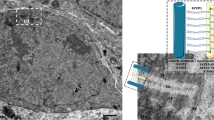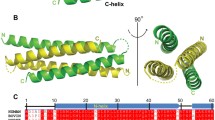Abstract
The highly ordered central region of the synaptonemal complex (SC) inBlaps cribrosa has recently been studied by electron microscope tomography (EMT), and a simple three-dimensional model presented. Using the same experimental approach we have now compared the central region inBlaps with the central regions inDrosophila melanogaster and rat. In all three species, the SCs exhibit a central element (CE) flanked by two lateral elements (LEs). The central region between the two LEs is crossed by transverse filaments (TFs). TheBlaps CE element is the most ordered one with a well-defined ladder-like structure with two longitudinal components bridged by a number of regularly spaced transverse components, the rungs of the ladder. At the junctions between the longitudinal and transverse components there are prominent dense structures. The CE is multi-layered with the ladders of the separate layers in approximate register. InDrosophila the transverse CE components are as distinct and well organized as inBlaps, while in rat they are present but are less frequent and less well ordered. The longitudinal CE components inDrosophila are often fragmented and even more so in rat. The tomographic analysis revealed that in all three species the central region contains the same structural units: a single TF associated with two short pillars (or globules), which correspond to the junction structures. A fibrous lattice connects the two pillars/globules on the same TF forming the transverse CE component and those on adjacent TFs forming the longitudinal CE component; fibers between pillars/globules also link consecutive CE layers together. In the longitudinal component the number of fibrous bridges between the pillars/globules is related to the conspicuousness of the longitudinal component, i.e.Blaps has most,Drosophila almost as many, and rat considerably fewer bridges. We conclude that the central region in rat,Drosophila andBlaps contains the same basic structural unit but the degree of order and concentration of the units differ: a higher density seems to be accompanied by a higher order within the CE.
Similar content being viewed by others
References
Carpenter ATC (1975) Electron microscopy of meiosis inDrosophila melanogaster females. I. Structure, arrangement, and temporal changes of the synaptonemal complex in wild-type. Chromosoma 51:157–182
Comings DE, Okada TA (1970) Whole mount electron microscopy of meiotic chromosomes and the synaptonemal complex. Chromosoma 30:269–286
Esponda P, Giménez-Martin G (1972) The attchment of synaptonemal complex to the nuclear envelope. An ultrastructural and cytochemical analysis. Chromosoma 38:405–417
Fuge H (1979) Synapsis, desynapsis, and formation of polycomplex-like aggregates in male meiosis ofPales ferruginea (Diptera, Tipulidae). Chromosoma 70:353–373
Giroux CN (1988) Chromosome synapsis and meiotic recombination. In: Kucherlapati R, Smith GR (eds) Genetic recombination. American Society for Microbiology, Washington, DC, pp 465–496
Moens PB (1968) The structure and function of the synaptonemal complex inLilium longiforium sporocytes. Chromosoma 23:418–451
Moens PB (1969a) The fine structure of meiotic chromosome polarization and pairing inLocusta migratoria spermatocytes. Chromosoma 28:1–25
Moens PB (1969b) Multiple core complexes in grasshopper spermatocytes and spermatids. J Cell Biol 40:542–551
Moses MJ (1968) Synaptinemal complex. Annu Rev Genet 2: 363–412
Rasmussen SW (1974) Studies on the development and ultrastructure of the synaptonemal complex inDrosophila melanogaster. CR Trav Lab Carlsberg 39:443–468
Rasmussen SW (1976) The meiotic prophase inBombyx mori females analyzed by three-dimensional reconstructions of synaptonemal complexes. Chromosoma 54:245–293
Roth TF (1966) Changes in the synaptonemal complex during meiotic prophase in mosquito oocytes. Protoplasma (Wien) 61:346–386
Schmekel K, Wahrman J, Skoglund U, Daneholt B (1993) The central region of the synaptonemal complex inBlaps cribrosa studied by electron microscope tomography. Chromosoma 102:669–681
Skoglund U, Andersson K, Strandberg B, Daneholt B (1986) Three-dimensional structure of a specific premessenger RNP particle established by electron microscope tomography. Nature 319:560–564
Solari AJ (1972) Ultrastructure and composition of the synaptonemal complex in spread and negatively stained spermatocytes of the golden hamster and albino rat. Chromosoma 39:237–263
Solari AJ, Moses MJ (1973) The structure of the central region in the synaptonemal complex of hamster and cricket spermatocytes. J Cell Biol 56:145–152
Sotelo JR, Wettstein R (1966) Fine structure of meiotic chromosomes. Comparative study of nine species of insects. Chromosoma 20:234–250
Stack MS (1984) Heterochromatin, the synaptonemal complex and crossing over. J Cell Sci 71:159–176
von Wettstein D, Rasmussen SW, Holm PB (1984) The synaptonemal complex in genetic segregation. Annu Rev Genet 18:331–413
Westergaard M, von Wettstein D (1970) Studies on the mechanism of crossing over. IV. The molecular organization of the synaptonemal complex inNeottiella (Cooke) Saccardo (Ascomycetes). CR Trav Lab Carlsberg 37:239–267
Westergaard M, von Wettstein D (1972) The synaptonemal complex. Annu Rev Genet 6:71–110
Wettstein R, Sotelo R (1971) The molecular architecture of the synaptonemal complex. Adv Cell Mol Biol 1:109–152
Author information
Authors and Affiliations
Additional information
Communicated by: D.P. Bazett-Jones
Rights and permissions
About this article
Cite this article
Schmekel, K., Skoglund, U. & Daneholt, B. The three-dimensional structure of the central region in a synaptonemal complex: a comparison between rat and two insect species,Drosophila melanogaster andBlaps cribrosa . Chromosoma 102, 682–692 (1993). https://doi.org/10.1007/BF00650894
Received:
Accepted:
Issue Date:
DOI: https://doi.org/10.1007/BF00650894




